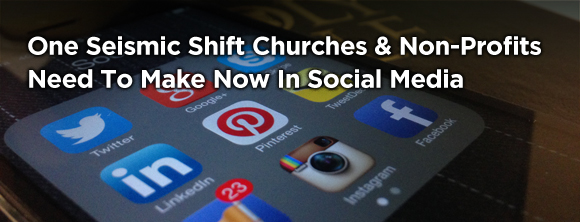One great recurring theme about social media is change. Change is constant and swift. If your social media plan was written in 2013 can may already be out of date with all of the recent shifts that have been going on. I have seen a many changes over the last year on social media, but there is one dramatic seismic shift that I want you to be able to plan for in social media that is coming in 2014/2015.
Is it a new social network? No, at least not this week. Has Facebook been sold to Murdoch already? Nope. This seismic shift will have more impact on you than any other change you will need to make if you are a church or non-profit.
Why?
Because it involves something that is scarce and hard to find around churches and non-profits. What is it?
It’s money.
The big seismic shift is this.
Social media is no longer free
For some of you this isn’t such a shock. And you’ve been spending a bit of money here and there. Most of us however have been riding the wave for the free that has been social media experience up until now.
Even if a church or non-profit has been investing a little bit of budget, for most it hasn’t been significant percentage of their overall marketing and communications spend.
Why the is there a seismic shift?
Social media is all grown up and wants some pocket-money. Seriously though, generally speaking social media is now not a new innovative passing fad, it is now a mature platform that is naturally part of most people’s everyday life. The innovators who started the platforms are moving on/selling up/out and the new wave of investors who have given them truck loads of money now want a return on their investment.
How will this impact you?
Facebook pages have been impacted for the last 6-12 months, lower reach which means less engagement has been a very noticeable trend which will only increase as Facebook matures it’s monetisation strategy (By the way Facebook did this on purpose so that we would all pay, sucks to be us huh?).
Twitter hasn’t been impacted so much in terms of your brand losing reach, yet. But money talks and seeing the folks over at Facebook rake in the dough will only increase pressure for increasing revenue returns. How they do this and how it can benefit or impact churches and non-profits is yet to be fully realised.
Instagram is the dark horse. Owned by Facebook, it is taking up a significant market share of the young audience from Facebook. It will monetise. It’s only a matter of time.
Google+ I’m still undecided about G+. But for search ranking alone it rocks. How Google step up the monetisation in the coming two years will be interesting to see.
There are of course different ways to monetise a social network. Some will impact you in the short-term, like Facebook and the reach issue. Some will take a few years to see how or if your brand is impacted at all.
You have a choice right now. Be the most visible, be in-front of the pack or slip back into the noise of the pack. Because soon paying for social will be just like paying for your email marketing software, TV, radio, PR, database, web hosting, app development. We all take those for granted now. Paying for social will be the new norm for the vast majority of organisations very soon. This is your opportunity to stay out in front.
What you need to plan and deliver now in 2014
1) Demonstrate/Convince your leaders on the why social media needs a budget line. What is the ROI for your church or non-profit? It’s no longer just about likes. Show pictures. Demonstrate the value. Inside tip: Leaders love to measure ‘reach’. (If you are a church or non-profit leader reading this, invest in social media. It is still very good value and gives you real reach to very specific audiences that traditional media can’t do.)
2) Budget and plan for 2015, that isn’t just spend on social, that is also staffing like design, video and photography.
3) Integrate social sharing throughout your digital presence/
4) Highlight your social media channels in every possible touchpoint. For us that is in our foyer screens, in our Sundays services, with staff, on our email communications, App, website. Make it easy for people to like, follow you in one click.
Here’s what I did in 2013
1) Budgeted for the first time a line item called ‘social media’. I highlighted it as a line item in my budget (which I don’t generally do for other communications channels) but I need to help the culture shift from ‘isn’t it free?’. My social media budget was 10% of my total marketing/communications spend in 2013. I saw shift coming in June 2012 and wanted to be ready for the changes ahead.
2) Regularly reported the ROI for my church to demonstrate the value it brings as the one of the primary communications channels we have moving forward.
3) Upped the social media emphasis on every touchpoint I had influence over.
Your turn
What changes are you seeing in social media? Do you already budget on social media or are you against it? Comment below.






